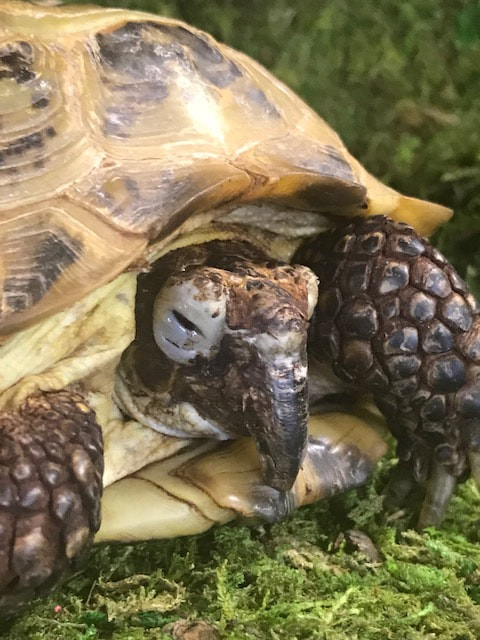Russian and Hermanns tortoises
Russian Tortoises (Testudo Horsfieldi) are a common species in the pet trade. They are from southeatern Russia, Iran, Afghanistan and Pakistan. It thrives in dry areas including rocky deserts, sandy areas and rocky hills. They also visit areas near small flowing water sources for the vegetation that grows near the sides. In the north, they do hibernate during the winter. Their diet consists of grasses, fruits, leaves and vegetables. This small toroise is almost as long as it is wide. The carapace is greenish yellow to a carmel color with dark seams. The plastron is hingeless, having dark blotches on the yellow coloration. The small scaled, yellowish-brown head has a slightly hooked upper jaw. The legs are also yellowish-brown with large non-overlapping scales on the front legs. There are 5 claws on the front legs as well. The males are smaller than the females, having claws and longer, thick tails with a spur on the end. During breeding, the male with head-bob and also rams into the female. The female will lay between 1 and 5 eggs. Incubation time is 8 to 10 weeks.
This Russian tortoise was not cared for properly. Her beak is overgrown and she has a Vitamin A deficiency
causing the whiteness of her eyes.
causing the whiteness of her eyes.
The Hermann's Tortoise (Testudo Hermanni) is found in Southern Europe, from Spain to Turkey, Corsica and Sicily. There are 2 subspecies of the tortoise. One has a long, flat and dull-colored carapace and does not have a light spot behind and under each eye. The other subspecies is smaller, high domed with brightly colored areas of yellow and black with a bright spot behind and under each eye. They live in dry meadows, woodlands and on rocky slopes, avoiding moist areas. They do hibernate in winter, under leaves and bushes. They have slightly hooked jaws and strong beaks. The male has a long thick tail with a spur on the end. Their courtship is similar to the Russian Tortoise. A female can lay up to 12 eggs, laying several clutches a year. Incubation is approximately 90 days. Their diet consists of beans, clovers and sometimes include earthworms, slugs and insects.








